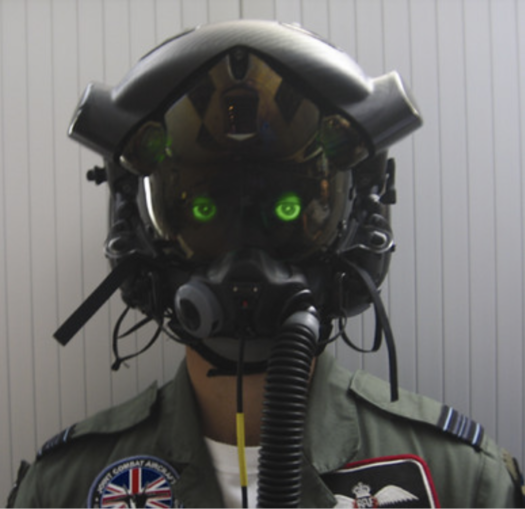
F-35 Joint Strike Fighter Developmental Pilot Helmet,
Image Editor – Licence CC BY-SA 2.0
In more relaxed times, a flight known as the Trooper originates from RAF Brize Norton in Oxfordshire. This summer, despite the weather, Operation Red Top was initiated to reduce heat damage to the base’s runway, obliging assembled passengers to an early-morning rise and a trip to Birmingham International Airport. There, you take your seat on CATS – the Cyprus Air Service. Four and three-quarter hours and 2,105 miles later you de-plane at the island’s Akrotiri Royal Air Force base.
Closeby 9,006ft long runway 10/28, base commander Group Captain Cloke, an old Hercules hand who arrived on the ‘peninsular always ready’ (base motto – Acra Semper Acria) via Kosovo, Afghanistan, the Middle East and Sierra Leonne, is on hand to inform you that, ‘Akrotiri is an extremely busy Permanent Joint Operating Base supporting ongoing operations in the region as well the Sovereign Base Areas on Cyprus.’
Used as a forward mounting base for overseas operations in the Middle East and for fast jet training, Akoteri is also home to the Cyprus Operations Support Unit which provides joint support to British Forces Cyprus and operations in the region that protect the UK’s strategic interests.
At the time of this visit, the focus was on evacuating British nationals from a warming civil war in Sudan. Since then the focus has moved. In a dynamic and rapidly changing region, this vital piece of real estate is now notable for being only 150 miles from Beirut, 170 miles from the border between Lebanon and Israel and 230 miles from Gaza City.
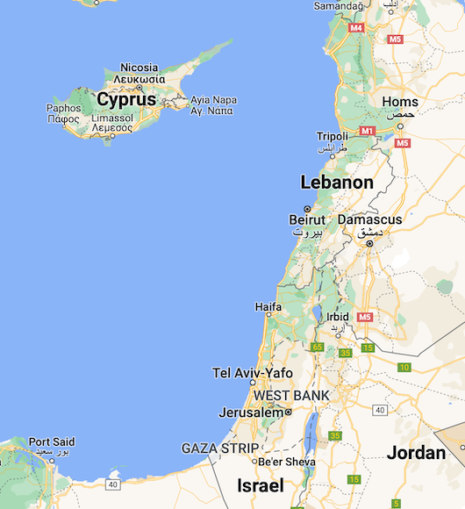
© Google Maps 2023, Google licence
Such things are situation normal at Akotiri. The last two decades have seen the RAF involved in various expeditionary roles often centred in or within striking distance of the Eastern Med. Operations in Libya, two Gulf Wars, the Syrian civil war, a bellicose Iran and the rise and fall of Islamic State, have seen a ‘Jane’s All The World’s Aircraft’ array of units stationed here. Combat aircraft such as Typhoons and Tornados, transports like Voyagers, Hercules and Tristars, practitioners of the dark arts including Sentinals, Sentries and Nimrods. All have busied the stands. It was not always the case. Akrotiri had an inauspisious start.
Constructed as a relief station in the 1950s for terrorist-affected Nicosia further north, Akrotiri is situated southwest of Limassol and covers the southernmost part of the island and a small coastal area north of Episkopi Bay. Next to a saltwater lake whose flamingos give the base its logo, the first thirty personnel arrived on July 1st 1955 to find a flat, dry, rocky, windswept scrubland. By the end of the following summer, station strength had reached 260 officers and 2,864 other ranks housed in caravans and tents between mud tracks being turned into proper roads. Hangers and permanent buildings were beginning to appear as well.
Upon independence in 1960, treaties established the Republic of Cyprus and also guaranteed the integrity of two areas of the island that remained Britsh; the West and East Sovereign Base Areas at Akrotiri and Dhekelia/Ayios Nikolaos respectively.
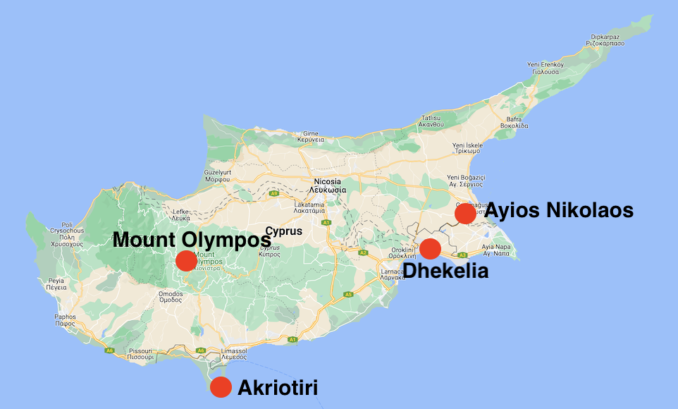
© Google Maps 2023, Google licence
With the Cold War and British withdrawal East of Suez, activity at Akrotiri increased in the 1960s and 70s. Permanently based squadrons included Lightnings, Canberras, Hercules, Argosys, Vulcans and, yes, U-2s, as the CIA arrived to monitor the era’s wars and ceasefires between Isreal and her neighbours.
For the arriving visitor, it is four pm. Following base familiarisation, the first challenge is how to dress and behave properly for an evening meal in the mess. The next days will include acclimatisation, swimming, other indoor and outdoor activities, beaches and a helicopter trip. The visitor can plan his own local cultural and nature excursions.
Also on the itinerary is a classified trip to one of the island’s sensitive intelligence-gathering establishments. During which the unique way in which Britain’s two Cyprus Sovereign Bases are administered reveals a free reign to the intelligence effort.
Pluto II
Next to the saltwater lagoon beside Akrotiri is a forest of antennae including a shortwave over the horizon (OTH) radar known as Pluto 2.
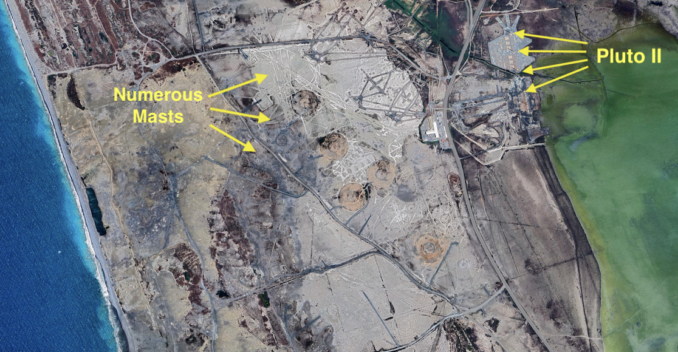
© Google Maps 2023, Google licence
Unlike conventional radar, shortwave radar can see over the horizon by bouncing short waves off the ionosphere. Aircraft, missiles and ground-based objects can be observed. The radars consist of a transmitting array and receiving arrays. The sheer size of these arrays demands they are pointed permanently in one direction but a ‘fan’ divergence from the perpendicular allows for a wide area to be covered.
With a range of over 3,000 miles, Pluto II is thought to give radar coverage over Iraq, Iran, the Gulf States, part of Saudi Arabia, most of Afghanistan, Pakistan, the former Soviet Stans, and possibly coverage over part of India. The Russian launch areas at Baikonur and Kapustin Yar are probably covered, as are the Persian Gulf and much of the Arabian Sea. BBC World Service transmitters are amongst the other masts.
Dhekelia And Ayios Nikolaos
The Eastern Sovereign Base Area is at Dhekelia, south of Nicosea and about 50 miles by road from Akrotiri. A 12-mile-long spur called Snake Road leads from Dhekelia to Ayios Nikolaos. On one side of this road is Cyprus and on the other side Turkey. The road itself is British sovereign territory. At Ayios Nikolas, we find the receiving arrays for Pluto II, right up against the UN Green Line buffer zone dividing Greek and Turkish Cyprus.

© Google Maps 2023, Google licence
The direction of the three rectangular arrays gives an idea of the angle width of Pluto II’s fan. A fourth more recent addition faces almost due north suggesting the radar now covers Belarus, Ukraine and the western part of Russia. We can also see satellite dishes of numerous sizes, pointing in various directions, and a very tall antenna. The dishes are used for the interception of transmissions from satellites. Position ‘A’ looks like a torus antenna, also known as a parabolic torus reflector antenna, capable of eavesdropping on dozens of satellites simultaneously.
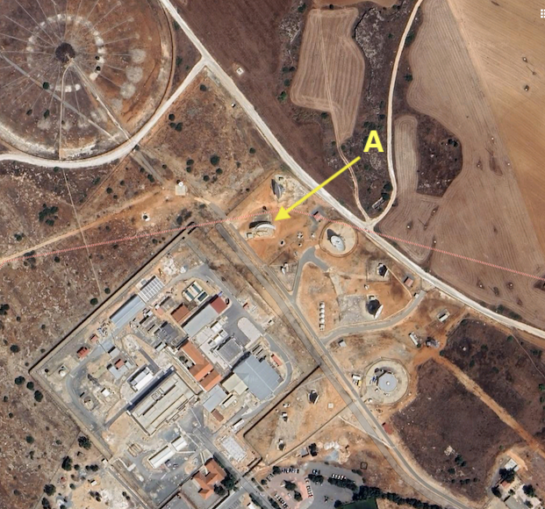
© Google Maps 2023, Google licence
This is Joint Service Signals Unit, one of the largest and most important SIGINT (signals intelligence) and ELINT (electronic intelligence) sites of British Government Communications Headquarters (GCHQ). Perhaps second in importance only to RAF Menwith Hill in Yorkshire. It is operated and funded jointly with the United State’s National Security Agency, the NSA.
If such a thing were ever to be made public, JSSU battle honours would include the 1948 Arab-Israeli War, the 1956 Suez Crisis, EOKA terrorism in the run-up to local independence, the 1967 Six-Day War, the 1973 Yom Kippur War, the 1974 Turkish invasion which partitioned Cyprus, and every other of the seemingly never-ending conflicts in this volatile part of the world.
Troodos Station
Outside of the sovereign base areas, there is another British military establishment retained on the highest point of the island, Mount Olympos. Known as Troodos station, at an altitude of 6,404 feet it handily sits next to a ski lift useful in the winter snows. You can have a look around here.
As a detachment of the JSSU, SIGINT and ELINT are collected here from a variety of sensors. Satellites and other smaller objects in space can also be observed. Maverick former British Ambassador to Uzbekistan, Craig Murray, claims to have been fully briefed on Troodos during a guided tour. He claims the station measures all radio, satellite and microwave traffic across the Middle East, ranging from Egypt and Eastern Libya all the way to the Caucasus. Even landline telephone communication is monitored as much of it is at least part-routed through microwave links.
Snowdon Revelations
NSA computer expert turned whistleblower Edward Snowden, currently resident in Russia and a naturalized Russian citizen, added some detail to these intelligence capabilities in his 2013 leaks.
Ayios Nikolas also intercepts vast quantities of emails, phone calls and web traffic carried on underwater fibre optic cables, under a GCHQ project entitled ‘Mastery of the Internet’. A programme called ‘Tempora’ taps internet cables passing over UK territory, including those in Cyprus, with the Cypriot branch of the operation known as ‘Sounder.’ Cyprus is the hub of numerous undersea cables; regional to the likes of Isreal, Syria, Lebanon, Egpyt, Turkey, Greece and Italy, but also intercontinental cable communications such as SEAMEWE3 which connects South East Asia, the Middle East and Western Europe.
These come ashore in Cyprus with interception occurring after a cable emerges from the sea at a landing station and travels overland to a data centre to connect with other cable networks. Fourteen undersea cables pass through Cyprus allowing access to tens of millions of emails, telephone calls, instant messages and other web-based traffic. GCHQ headquarters in England and the NSA centre at Ford Gordon in the USA contain hundreds of analysts who speak Middle Eastern and surrounding languages. They are connected in real-time to the flows of intercepted public calls and messages captured by eavesdropping.
During the 2008 conflict between Isreal and Gaza, leaked internal publications show intercepts from Cyprus and processed at RAF Menwith Hill could even retrieve data from the cockpits of Israeli aircraft and unmanned aerial vehicles (UAVs), including video from the head-up displays of F-16s.
Two Eyes Become Three
That the UK, USA and Israel share intelligence is well established and in the public domain. A 2017 article in the Jewish Chronicle revealed that for the first time a Director General of GCHQ, Robert Hannigan, had talked about the organisation’s ‘strong partnership with our Israeli counterparts in signals intelligence’. At a Conservative Friends of Isreal event, Mr Hannigan spoke of a new National Cyber Security Centre based upon a relationship with a range of Israeli bodies including the Be’er Sheva-based cyber industry, aimed at protecting British, Israeli and other nationalities from terrorism.
During the present conflict, it has been reported that British electronic surveillance aircraft have been conducting patrols ‘near Israel’ to help ‘locate hostages’.
October 7th Intelligence Failure
After initial shock and confusion, the serious end of mainstream analysis has coalesced around some bullet-point conclusions regarding October 7th and by implication the failure of the ‘peninsular always ready’.
- Misunderstood intention
- Misunderstood operational readiness
- Over-reliance on electronic intelligence
- Over-reliance on the smart border
- A distracted Israel and USA
- A well-prepared and counter-intelligence-savvy Hamas
A two-year-long deception campaign led Israeli intelligence to believe that Hamas’s main intent was to foster economic development in Gaza and to restore Hamas as a legitimate political entity. During this time, relative to fellow travellers in the West Bank, Southern Lebanon and Syria, Hamas limited hostile encounters with Isreal while appearing to be reluctant to engage in major warfare. The deception included disseminating false information through known compromised communications.
The Hamas tunnel system was more extensive and robust than thought. The Israeli policy of ‘mowing the grass’ with regular small attacks proved ineffective. Hamas had a large number of ‘sleeper’ fighters who could be called to arms quickly with little previous knowledge of an operation.
Israel over-relied on technology. Their technological and military superiority was also assumed to be a deterrent to Hamas from launching an assault. Israel relied on intelligence gathered from satellites, aircraft, drones and other sensor-equipped platforms. Confident in its advanced SIGINT and imagery intelligence (IMINT) collection capabilities, Israel neglected human intelligence (HUMINT) gathered on the ground. Gaza is a difficult operating environment for human intelligence gathering. It is a denied area behind a secure border and from a population of 2.3 million less than 1,000 are non-Muslim. Getting people into the territory or recruiting and keeping local sources is difficult.
Israel also placed significant reliance upon the 40-mile-long wall enclosing Gaza. This sophisticated above and below-ground barrier is supported by an extensive surveillance and weaponry network. Towers send information from cameras and motion sensors to command posts. Remote control guns operate along the border fence. As dawn rose on October 7th, the barrier proved to be breachable.
In recent years, Israel has focused on Iran, the civil war in Syria, Hezbollah in Southern Lebanon, Iran, the fractious West Bank that Israel occupies, and domestic civil upheaval caused by opposition to Prime Minister Netanyahu’s judicial reform. The week before 7th October was the Jewish public holiday of Sukkot. The actual day was the Sabbath. Similarly, the United States’ long-term focus has been on Al-Qaeda, Islamic State, Afghanistan and Iran. Ludicrously, British counter-terrorism intelligence gathering sees massive resources aimed at the nonsense of extreme-far-hard Right teenagers watching YouTube in their bedrooms, and eavesdropping on middle-aged men in pubs venting about their local MP.
Meanwhile, Hamas were making their preparations, including compiling an excellent knowledge of Isreal’s defence system from information in the public domain (open sources – OSINT) and from human intelligence passed to them by the 17,000 Gazans who cross the border every day to work in menial jobs in Southern Israel. Kibbutznik from the attacked settlements have claimed Hamas insurgents knew the layout not only of the kibbutz but of the internal plans of individual buildings and the whereabouts of emergency shelters.
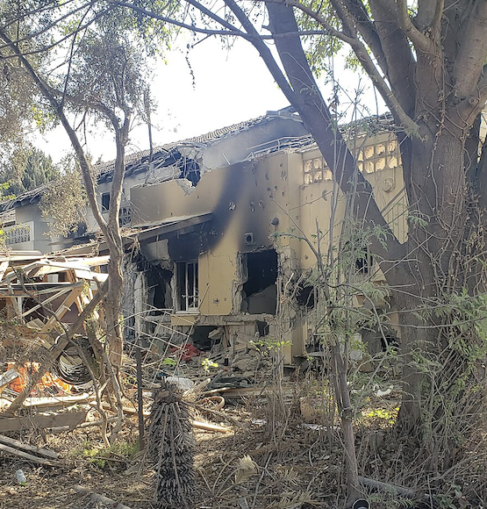
Kibbutz Be’eri after the massacre,
Tomer Persico – Licence CC BY-SA 2.0
A massive rocket bombardment preempted sunrise on the fateful Saturday. The Iron Dome was fully occupied looking for and intercepting rockets heading north as far as Tel Aviv. Elsewhere, quadcopter drones attacked surveillance towers. Paragliders secured the Israeli side of the border. With surveillance blinded and remote-controlled guns neutralised, low-tec bulldozers and explosives were used to beach the smart border. Low-tech motorbikes, cars and trucks were used to take Hamas short distances to nearby Jewish settlements whose inhabitants were massacred.
In the run-up to the attack, strict compartmentalisation meant only a small number of senior people knew of the plan. They communicated below the intelligence radar using strong ‘stick and brick’ tradecraft. They refrained from using phones. Handheld radios were used to coordinate the attack. According to a report in the New York Times, this mode of communication had previously been deprioritised by Israeli SIGINT.
Whether the above mainstream bullet points are comprehensive or convincing is open to debate. Certainly, the presence of drones and paragliders in the territory should have raised suspicions. What can be said for certain must echo General Herzi Halevi, Chief of the General Staff of the Israeli Defence Force, who declared, ‘We will investigate, but now is the time to fight.’ Given the sensitive and classified nature of the intelligence effort and the enormity of the October 7th failure, it is unlikely any official investigatory findings will ever be disclosed to the public.
Acknowledgements & Further Reading
Spy Island
Hobbyist Blog, Pluto II
Giorgos Georgiou, British Bases in Cyprus and Signals Intelligence
Matt Kennard, Inside Britain’s Military Dictatorship in The Mediterranean
The Guardian, British Base on Cyprus Rocked by Riots
L’Expresso, Snowden Leaks
Intelligence Failure Articles
Center For Strategic And International Studies
Center For Strategic And Contemporary Research
© Always Worth Saying 2023



